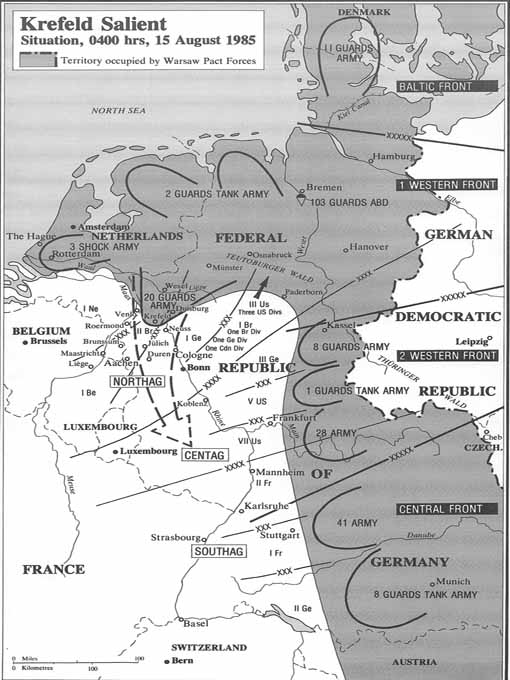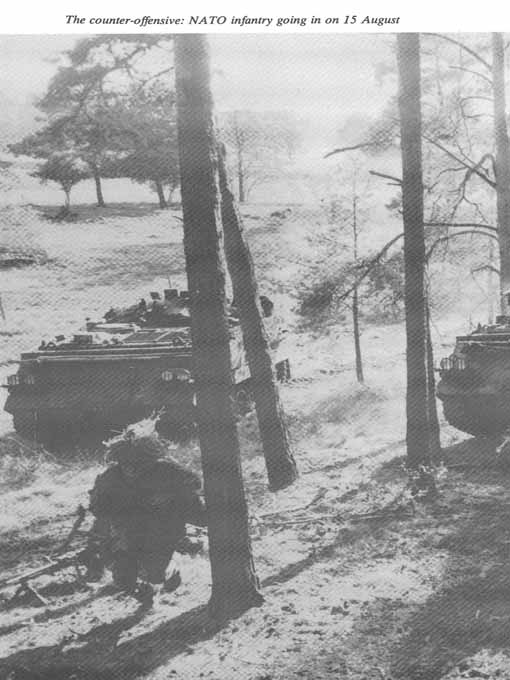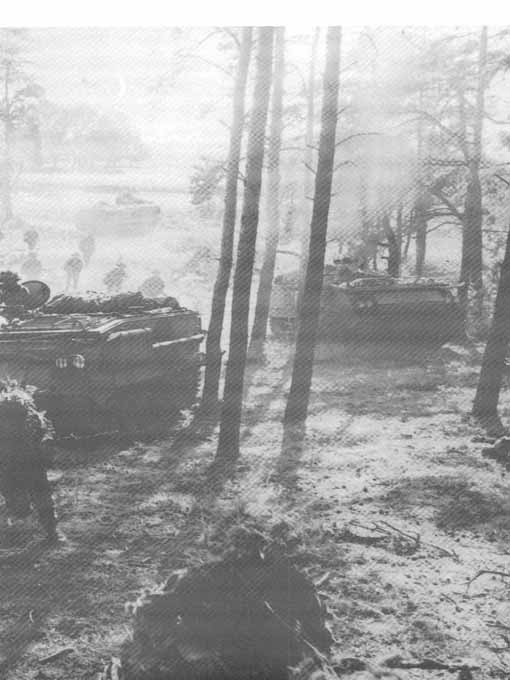The Third World War - The Untold Story (33 page)
Read The Third World War - The Untold Story Online
Authors: Sir John Hackett
Tags: #Alternative History

The essence of the plan was that the F-111/
Tornado
force, having flown over southern Norway to Sweden, would approach Poland from the north. Flying across the Polish plain at 70 metres or so they would have an excellent chance of avoiding detection until well over the coast, when the distance to run would be only 180 kilometres to Poznan and 270 to Wroclaw, and this would be covered in twelve to eighteen minutes’ flying. By refuelling and setting out from Sweden, the northern flank of the Warsaw Pact defences would be turned. This was the key to the whole operation. Evasive routing would keep them clear of the worst of the fixed defences which would anyway have minimum warning of their approach. With luck they might be taken completely by surprise. The force would be split when it crossed the Wista river north of Bydgoszcz and the two parts would then head separately to their targets. A hot reception by fighters would undoubtedly be waiting for them on their way back but they would have to rely on their speed and keeping as low as possible in the dark to get them through.
At midnight, and with a bare minimum of airfield lighting, the two Wings landed at the
Flygvapnet
air bases of Kalmar and Kallinge. All thirty aircraft were refuelled and ready in little more than an hour before taking off again on their mission at 0200 hours. The primary targets were the multi-span bridges over the Warta and Oder rivers, which carried the main railway lines to Berlin from Warsaw and Krakow. Long trains of transporter floats, each train carrying up to fifty T-72 tanks or equivalent loads, were moving slowly to the west around the cities of Poznan and Wroclaw, sometimes spaced no more than a 100 metres apart. It would be a rewarding operation indeed if that flow could be halted, but bridges had always been difficult targets in air warfare. From above, it took only a small line error to produce a complete miss and bridges were designed to take heavy loads in the vertical plane anyway. Now it was all different: they were going to be hit sideways by missiles fired from 3,000 metres’ range with radar and infra-red homing weapons striking the bridge piers like giant hammers on a demolition job. Any missiles or bombs left over would be launched at whatever trains they could find in their path on the way out.
The
Tornados
led both streams as they divided over the Wista river to the north. Their first task was to bring anti-radiation defence suppression weapons to bear against the SAM systems around the cities and on the bridges and to clear the way for the heavier armament of the FB-111s.
At the first bridges they had an easy ride, but when the gunners dozing over their ZSU radar-controlled anti-aircraft guns woke up to what was happening they put up such a dense curtain of fire that four
Tornados
had gone down before the batteries were silenced. Five FB-111s went the same way and two which had been straggling a bit had fallen to SAM near Bydgoszcz to the north when the force had split. In all, four bridges went down, with spans crumpling into the rivers carrying two trains with them. This was a tremendous achievement, of critical importance to the battle on the Central Front.
Nineteen out of the original force of thirty aircraft swept round out of the target area to battle their way back along the shortest route to the Baltic west of Gdansk.
The defences were now fully alerted but it was still dark, and flying not far below the speed of sound a bare 70 metres above the flat terrain they were a very difficult target for the MiG-23
Floggers
of the GDR and Polish Air Forces waiting for them to the north. One more
Tornado
and an FB-111 went at this stage but, although it is difficult to know even now, it was the general opinion of the crews in the easterly stream that the Polish fighters had not pressed home their attacks with much enthusiasm.

Four of the seventeen surviving aircraft with heavy battle damage made distress calls and, taking the Swedes at their word, put their aircraft down on the ground in the first light of dawn at Kallinge air base. Four Soviet Air Force
Foxbats
in hot pursuit into Swedish airspace were met by interceptors and the greater agility of the Swedish
Viggens
sent two of the
Foxbats
down before the other two turned away and headed back towards Leningrad.
The two commanders, the American and the Briton, were still in the lead of their sections as the remaining aircraft flew on low over the sea towards the west. They had agreed the day before that they would cut the south-west corner of Sweden very fast and close to the ground, before pulling up over the mountains to make their pre-planned landing at Oslo in Norway.
Next day was to see the massive B-52 onslaught on the front line near Venlo. If that was the bludgeon blow, this daring and skilful attack by night intruders had been the rapier thrust. As had looked likely, the enemy’s heavy bridging equipment had been taken well forward into East Germany, where it expected to be attacked, and where, of course, it repeatedly was. This resulted in scarcity of bridging and recovery equipment further back. Many trains had now to be sent back to Warsaw and Krakow and laboriously re-routed through Czechoslovakia to the south and Bydgoszcz to the north. On the map it looked like a relatively easy exercise, but yet again the inflexibility of Warsaw Pact plans was to create difficulties. Even more resulted from widespread sabotage by Polish workers, acting on exhortation and instruction over Western radio broadcasts. In all, the rapier had added a telling thirty-six hours or so to Soviet reinforcement timings. This was to multiply and would greatly exacerbate Warsaw Pact problems after the B-52 attack on the front line next morning, 15 August.”*
* Air Vice-Marshal Alec Penteith RAF, Tornados in World War III (Chatto and Windus, London 1986), p. 265.

The position near Venlo on the front of II British Corps, whose four divisions were flanked on the right by a US brigade and on the left by I Netherlands Corps, was critical. By nightfall on 14 August the Soviet 20 Guards Army was not far from achieving the front commander’s object, which was to force a way through the Allied forces defending the point of the Krefeld salient that Soviet forces had driven between Duisburg and Venlo, and thus open the possibility of carrying out the truly critical part of the whole Warsaw Pact operational plan. This was still, once a crossing had been forced over the lower Rhine, to swing left upstream and take CENTAG from the rear.


Already trans-Atlantic reinforcement was building up and the massive augmentation the Soviet Union had hoped to forestall was well under way. The arrival in the Central Region of a fresh US corps was imminent. Its advanced parties began to arrive in the Aachen area early on the 15th. A French armoured division was approaching Maastricht. SACEUR had released four divisions from his last theatre reserves to NORTHAG, as from 0001 hours on 14 August, for the counter-offensive north-eastwards towards Bremen to open at first light on the 15th.
This was to be a critical day in the history of the Third World War. At the point of the Krefeld salient Soviet troops had penetrated II British Corps and by nightfall on 14 August Soviet tanks were not far from Julich. Unless the Soviet advance could be held up on 15 August the fresh US corps and the additional French division could not be brought into action in time, the NORTHAG counter-offensive towards Bremen would be stillborn, and the whole Allied position in the Federal Republic would be threatened by the Soviet thrust southward, up the left bank of the Rhine, in CENTAG’s rear. This, it was clear, was the time to use the B-52s standing by at Lajes in the Azores. On the morning of 14 August SACEUR ordered COMAAFCE to make a maximum effort at first light on the 15th, to slow down the Soviet advance and help to stabilize the position in the Krefeld salient. The action of the B-52 bomber force, at what was a truly crucial moment of the war, deserves attention in some detail.
All were aware, ground and air commanders alike, that the practical problems raised by the decision to use the B-52s would be difficult to resolve. Defending forces would have to break contact far enough and long enough to give the B-52s a bomb line that would permit the maximum impact on Warsaw Pact armour with minimum casualties in NATO forward positions. That, COMAAFCE must have reflected pragmatically on the morning of 14 August, was now the army’s problem; his was to get as many of the B-52s as possible over the Krefeld salient at 0400 hours local time the following day.
The targeting directive was received at Lajes at 1200 hours local time on the 14th. During the previous week the crews had increased the customary proportions of alert status, which ran from fifteen minutes to six hours. By 1500 hours that day the last batch of air tests was complete and thirty-nine of the B-52s were declared serviceable for the mission. It was now that the expertise built up by air crew and ground crew in several years of European exercises paid handsome dividends. One hundred MK-82 bombs were loaded into each bomb bay and, although the round trip of 4,000 miles would be well within B-52 range, a full fuel load was taken on board. By 2200 hours air crew briefings were completed. The target area was a strip of territory 10 kilometres from north to south by 2 kilometres east to west, due west of Neuss. It was believed that in that area at least three divisions of 20 Guards Army, with probably one or two of the leading regiments of the second echelon, would be concentrating for a final breakthrough. In practical terms the targets would include at least 20,000 troops, 1,000 tanks, 500 BTR and a further 1,500 soft-skinned vehicles essential to the forward momentum of the ground attack. The terrain was flat and offered little natural cover. The proximity of an
Autobahnkreuz
afforded a near-perfect identification point for either visual or radar bombing. Time on target would be 0400 hours and bombing height would be 40,000 feet.
The B-52s carried a wealth of defensive equipment but exercises during the previous five years had pointed the need for fighter escort. On this occasion that responsibility was to be shared amongst French
Mirage
F-1Cs, 2000s and USAF F-15s. The B-52s’ route would take them north-eastwards across the Pyrenees and up across France and Luxembourg towards Cologne, where they would begin their bombing run.
